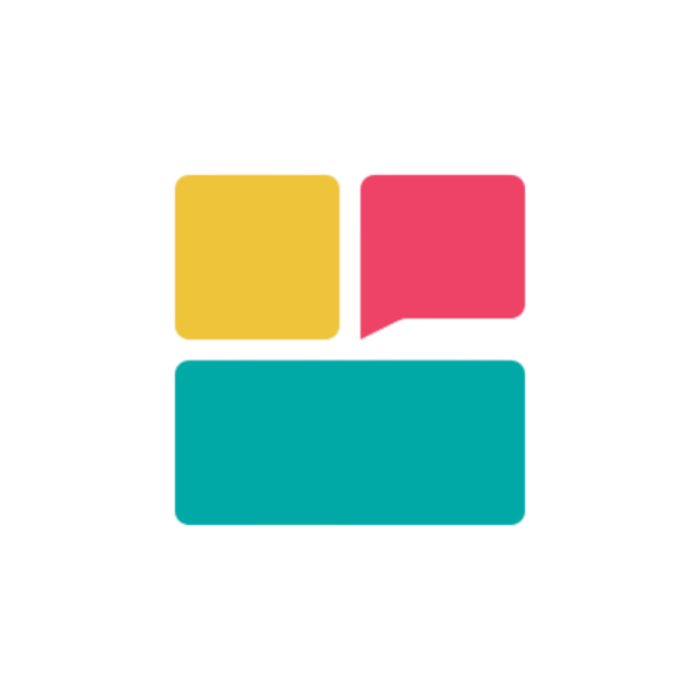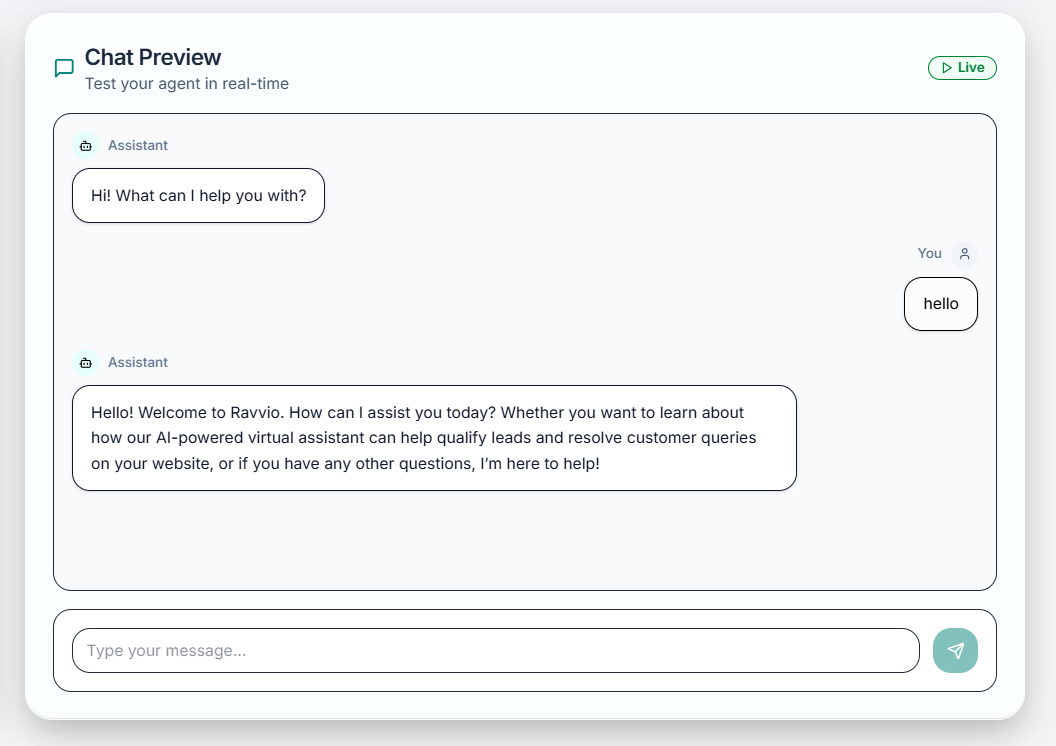Testing Workflow Overview A systematic testing workflow ensures your AI agent performs optimally before deployment, providing consistent, accurate, and helpful responses that align with your business objectives and brand voice.
Workflow Benefits
Quality Assurance Systematic validation of agent performance before live deployment
Risk Mitigation Identify and resolve issues in safe testing environment
Performance Optimization Continuous improvement through structured testing cycles
User Experience Ensure optimal user interactions and satisfaction
Pre-Testing Preparation Initial Setup Requirements
Configuration Review
System Prompt Validation:
Verify system prompt completeness and clarity
Ensure personality traits align with brand voice
Confirm expertise areas match business focus
Validate response style preferences
Agent Settings Check:
Review agent name and identification
Confirm lead capture configuration
Validate demo booking integration settings
Check knowledge base connection status
Knowledge Base Verification
Content Assessment:
Confirm all relevant documents are uploaded
Verify processing completion and index status
Review content organization and structure
Validate information accuracy and currency
Coverage Analysis:
Identify potential knowledge gaps
Ensure comprehensive topic coverage
Verify FAQ and common question inclusion
Check product/service information completeness
Test Scenario Planning
Scenario Development:
Define user personas and interaction types
Create comprehensive question sets
Plan edge case and stress testing
Establish success criteria and metrics
Testing Environment:
Access playground with appropriate permissions
Prepare testing tools and documentation
Set up performance monitoring
Configure session management preferences
Testing Objectives Definition
Core Functionality:
Validate accurate responses to common questions
Confirm appropriate handling of complex queries
Test knowledge base information retrieval
Verify lead capture and conversion flows
Performance Standards:
Response time within acceptable limits
Consistency across different conversation types
Appropriate escalation and fallback behaviors
Integration functionality with external systems
Response Quality:
Accuracy of information provided
Relevance to user questions and context
Consistency with brand voice and personality
Helpfulness and user satisfaction potential
User Experience:
Natural conversation flow and transitions
Clear and understandable language use
Appropriate response length and detail
Engaging and professional interaction style
Core Testing Workflow Phase 1: Basic Functionality Testing
System Initialization
Environment Setup:
Start new playground session
Confirm agent configuration is active
Verify knowledge base connectivity
Check system prompt application
Initial Validation:
Send simple greeting to test basic responsiveness
Verify agent personality and tone consistency
Confirm appropriate introduction and context
Test basic conversational capabilities
Core Feature Testing
Essential Functions:
Test response to frequently asked questions
Validate product/service information accuracy
Confirm pricing and availability queries
Test contact information and support processes
Knowledge Base Integration:
Ask questions that should reference uploaded documents
Verify accurate information retrieval
Test cross-referencing between different documents
Confirm proper source attribution when relevant
Lead Capture Validation
Capture Flow Testing:
Test natural lead capture integration
Verify email collection forms function correctly
Confirm demo booking integration works properly
Validate data storage and accessibility
Conversion Optimization:
Test different approaches to requesting contact information
Evaluate timing and context of capture attempts
Assess user experience and friction points
Optimize messaging for better conversion rates
Phase 2: Advanced Scenario Testing
Multi-Part Questions:
Test questions with multiple components
Verify comprehensive response coverage
Confirm logical organization of information
Assess clarity and completeness of answers
Context-Dependent Queries:
Test follow-up questions requiring conversation context
Verify proper context maintenance across interactions
Confirm appropriate reference to previous messages
Assess conversation flow and natural transitions
Boundary Conditions:
Test questions outside knowledge base scope
Verify appropriate handling of unknown topics
Confirm graceful fallback responses
Test escalation triggers and human handoff
Unusual Interactions:
Test responses to inappropriate or off-topic questions
Verify professional handling of difficult situations
Confirm security and privacy protection measures
Assess error handling and recovery capabilities
Response Time Analysis
Performance Metrics:
Measure individual response times
Calculate average response speed
Identify slow response patterns
Compare against performance benchmarks
Optimization Opportunities:
Identify knowledge base queries causing delays
Assess system prompt complexity impact
Test configuration changes for speed improvement
Validate optimizations maintain quality standards
Consistency Testing
Response Validation:
Ask same questions multiple times
Verify consistent information and tone
Test response stability across sessions
Confirm personality maintenance throughout conversations
Quality Assurance:
Compare responses to similar questions
Evaluate information accuracy and completeness
Assess user experience consistency
Validate brand voice alignment across interactions
Iterative Improvement Process Testing Cycle Implementation
Test-Analyze-Improve Continuous Improvement:
Conduct systematic testing sessions
Analyze results and identify improvement opportunities
Implement configuration changes and optimizations
Retest to validate improvements and measure progress
Data-Driven Decisions Metrics-Based Optimization:
Track performance metrics over time
Identify trends and patterns in agent performance
Make evidence-based configuration adjustments
Monitor impact of changes on key success metrics
Configuration Refinement Process
Issue Identification
Document specific problems or improvement opportunities identified during testing
Root Cause Analysis
Investigate underlying causes of performance issues or quality problems
Solution Implementation
Make targeted changes to system prompts, knowledge base, or configuration settings
Validation Testing
Retest specific areas to confirm improvements and validate solution effectiveness
Quality Assurance Framework Testing Documentation
Test Scenario Recording:
Document all test scenarios and questions used
Record expected vs. actual responses
Note configuration settings during testing
Track performance metrics and quality ratings
Issue Tracking:
Log all identified problems and improvement opportunities
Document resolution steps and configuration changes
Track improvement progress over time
Maintain audit trail for quality assurance
Team Collaboration
Stakeholder Review
Share testing results with relevant team members for feedback and validation
Collaborative Optimization
Work with marketing, sales, and customer service teams to refine agent responses
Business Alignment
Ensure agent performance aligns with business objectives and customer expectations
Approval Process
Obtain appropriate approvals before deploying optimized configuration to production
Testing Best Practices Systematic Approach
Comprehensive Coverage Testing Scope:
Cover all major use cases and customer scenarios
Test both common and edge case interactions
Validate all agent features and integrations
Ensure testing reflects real user behavior patterns
Realistic Testing User Simulation:
Use actual customer questions from support logs
Test with different user personas and interaction styles
Simulate various customer journey stages
Include mobile and desktop testing scenarios
Optimization Guidelines
Regular Testing Schedule:
Conduct weekly testing sessions during initial optimization
Implement monthly testing for ongoing maintenance
Perform testing after any configuration changes
Schedule quarterly comprehensive reviews and optimizations
Adaptation and Evolution:
Update testing scenarios based on actual user feedback
Incorporate new business information and changes
Adapt to seasonal or promotional content updates
Evolve testing approach based on lessons learned
Deployment Readiness Assessment Pre-Deployment Checklist
Functionality Validation
Complete Feature Testing:
All core functions tested and working correctly
Knowledge base integration fully operational
Lead capture and demo booking systems validated
Performance metrics meet established benchmarks
Quality Standards:
Response quality consistently meets or exceeds expectations
Brand voice and personality alignment confirmed
User experience optimized for target audience
Edge case handling appropriate and professional
Performance Validation
Technical Requirements:
Response times within acceptable limits
System stability under various load conditions
Integration with external systems functioning properly
Error handling and recovery mechanisms working
User Experience:
Conversation flow natural and engaging
Information provided accurate and helpful
Lead capture process smooth and non-intrusive
Mobile and desktop compatibility confirmed
Business Alignment
Strategic Objectives:
Agent responses support business goals
Lead generation and conversion optimization complete
Customer service standards met or exceeded
Brand representation consistent and professional
Stakeholder Approval:
Testing results reviewed and approved by relevant teams
Configuration changes documented and validated
Deployment timeline and rollback plans established
Success metrics and monitoring plans defined
Final Validation Process
Comprehensive Testing Review
Documentation Review:
Complete testing documentation and results
All identified issues resolved or documented
Configuration changes logged and validated
Performance metrics within acceptable ranges
Quality Assurance:
Independent validation of critical functionality
Peer review of testing results and conclusions
Verification of business requirement fulfillment
Confirmation of deployment readiness criteria
Deployment Planning:
Production deployment strategy defined
Monitoring and alerting systems configured
Rollback procedures documented and tested
Support team briefed on new configuration
Launch Monitoring:
Real-time performance monitoring during initial deployment
User feedback collection mechanisms activated
Support escalation procedures reviewed and ready
Success metrics tracking initiated
Post-Deployment Testing Production Validation
Initial Monitoring
Monitor agent performance closely during first 24-48 hours after deployment
User Feedback Collection
Gather initial user feedback and interaction data for analysis
Performance Assessment
Compare production performance against testing environment results
Optimization Opportunities
Identify any additional optimization opportunities based on real user interactions
Ongoing Maintenance Testing
Regular Health Checks Scheduled Testing:
Weekly spot checks of core functionality
Monthly comprehensive testing sessions
Quarterly full system reviews and optimizations
Annual strategic alignment and capability assessment
Adaptive Testing Dynamic Optimization:
Response to user feedback and support requests
Adaptation to business changes and new products
Seasonal content updates and testing
Competitive analysis and feature enhancement
Testing Documentation : Maintain comprehensive records of all testing activities, results, and optimizations to support continuous improvement and knowledge sharing.
Regular Reviews : Schedule regular testing workflow reviews to identify opportunities for process improvement and ensure testing remains aligned with business objectives.
Production Impact : Never test experimental configurations directly in production. Always validate changes thoroughly in the playground environment first.

